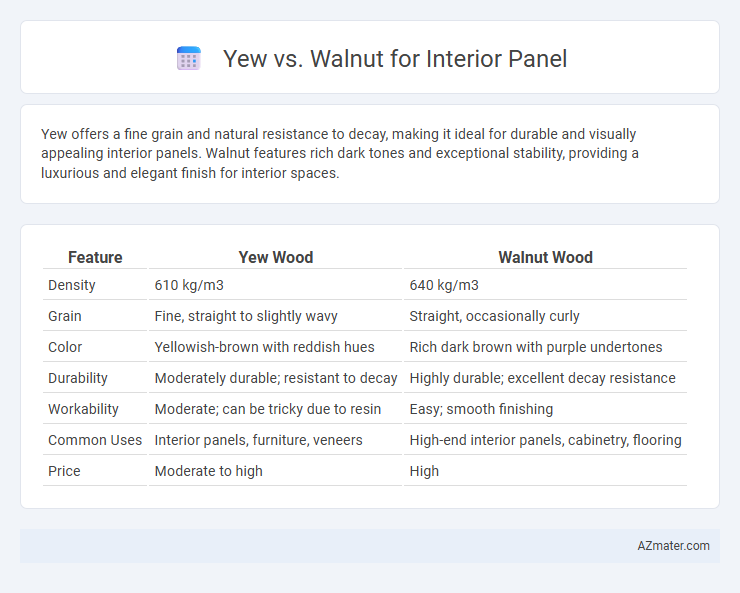Yew offers a fine grain and natural resistance to decay, making it ideal for durable and visually appealing interior panels. Walnut features rich dark tones and exceptional stability, providing a luxurious and elegant finish for interior spaces.
Table of Comparison
| Feature | Yew Wood | Walnut Wood |
|---|---|---|
| Density | 610 kg/m3 | 640 kg/m3 |
| Grain | Fine, straight to slightly wavy | Straight, occasionally curly |
| Color | Yellowish-brown with reddish hues | Rich dark brown with purple undertones |
| Durability | Moderately durable; resistant to decay | Highly durable; excellent decay resistance |
| Workability | Moderate; can be tricky due to resin | Easy; smooth finishing |
| Common Uses | Interior panels, furniture, veneers | High-end interior panels, cabinetry, flooring |
| Price | Moderate to high | High |
Introduction to Yew and Walnut Wood
Yew wood is valued for its fine grain, rich reddish-brown color, and exceptional durability, making it a popular choice for elegant interior panels and traditional woodworking projects. Walnut wood is renowned for its deep chocolate-brown hues, straight grain, and natural luster, offering a sophisticated and timeless appearance ideal for high-end interior paneling. Both woods provide unique aesthetic qualities and robust performance, with yew excelling in classic warmth and walnut delivering modern luxury.
Botanical Background and Sources
Yew (Taxus baccata) is a coniferous evergreen tree native to Europe, known for its dense, fine-grained heartwood prized in luxury interior paneling. Walnut (Juglans regia), a deciduous hardwood tree originally from the Persian region, offers rich, dark brown heartwood with straight grain patterns favored for elegant indoor applications. Both species derive from temperate climates, with yew sourced mainly from European forests and walnut commonly harvested from North American and Central Asian woodlands.
Appearance: Color and Grain Patterns
Yew wood features a rich golden-yellow to reddish-brown hue with fine, straight grain patterns that create a smooth and elegant surface for interior panels. Walnut is prized for its deep chocolate brown color with occasional purplish or gray undertones and striking, complex grain variations that add dramatic visual interest. Both woods offer unique aesthetic qualities, with Yew providing a lighter, warmer appearance and Walnut delivering a darker, more sophisticated look.
Durability and Hardness Comparison
Yew wood exhibits moderate hardness with a Janka rating of approximately 1,130 lbf, making it less durable for high-traffic interior panels compared to walnut. Walnut, particularly black walnut, has a Janka hardness around 1,010 lbf, but its consistent density and resistance to wear contribute to improved longevity and stability in interior panel applications. Both woods offer aesthetic appeal, yet walnut generally outperforms yew in terms of balanced durability and hardness for long-lasting interior paneling.
Workability and Finishing Qualities
Yew wood offers excellent workability due to its fine grain and moderate hardness, allowing for precise carving and smooth sanding, making it ideal for detailed interior paneling. Walnut, known for its rich color and uniform texture, also provides outstanding finishing qualities, absorbing stains and oils evenly for a luxurious appearance. Both woods respond well to hand and machine tools, but Walnut typically requires less effort during finishing due to its stable grain structure and natural resistance to warping.
Cost and Availability in the Market
Yew wood generally costs more than walnut due to its rarity and limited supply, making it less commonly available in the market for interior paneling. Walnut, being more abundant and widely sourced, offers a more affordable and readily accessible option for interior panels. Market availability significantly favors walnut, ensuring consistent pricing and supply chains for large-scale interior projects.
Environmental Impact and Sustainability
Yew wood, known for its slow growth rate, is less sustainable than walnut, which grows faster and is more readily renewable. Walnut's wider availability reduces deforestation pressure, while yew harvesting may threaten biodiversity due to its limited supply. Choosing walnut for interior panels supports eco-friendly forestry practices and lowers environmental impact by promoting sustainable wood sourcing.
Maintenance and Longevity
Yew wood offers moderate maintenance with natural oils that resist decay, making it suitable for interior panels requiring durability and a warm aesthetic. Walnut demands periodic sealing and conditioning to preserve its rich color and prevent surface scratches, enhancing its long-term beauty and strength. Both woods demonstrate excellent longevity when properly maintained, but walnut's hardness provides greater resistance to dents and wear over time.
Best Applications for Interior Paneling
Yew wood offers a rich, warm hue with excellent natural durability, making it ideal for decorative interior panels in luxury spaces or feature walls where aesthetic appeal and resilience are key. Walnut provides a deep, chocolate-brown tone with fine grain patterns, excelling in high-end cabinetry, furniture panels, and sophisticated wall treatments requiring both elegance and stability. Both woods resist warping and wear, but Yew's lighter color suits bright, traditional interiors while Walnut's darker shade enhances modern or classic designs with a timeless, refined finish.
Choosing Between Yew and Walnut: Key Considerations
Choosing between Yew and Walnut for interior paneling involves evaluating factors such as grain patterns, durability, and color tones; Yew features a lighter, warm yellow hue with fine grain and natural resin pockets, offering moderate hardness and resistance to decay. Walnut, prized for its rich, dark brown color and straight grain, provides superior strength and dimensional stability, making it ideal for high-traffic areas or statement walls. Cost and availability also influence selection, as Walnut tends to be more expensive and sourced from temperate regions, while Yew is less common but valued for its unique aesthetic and historical significance.

Infographic: Yew vs Walnut for Interior Panel
 azmater.com
azmater.com